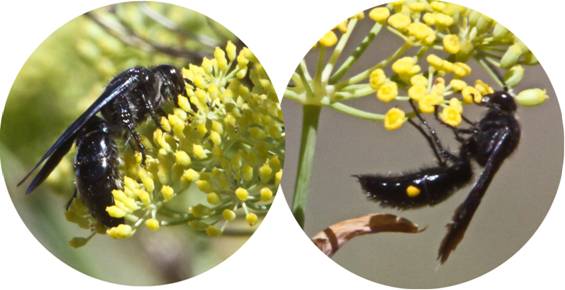I think this might be the same wasp that has been hanging around
my flowering oregano (in Braidwood) – the photos show the same wonderful
blue sheen to its wings. More importantly – does it sting, apart
from looking beautiful and sinister? I’d be interested to
know what its range is because I’ve never seen any in Melbourne/Victoria.
From: Geoffrey Dabb [
Sent: Friday, 25 March 2011 12:33 PM
To:
Subject: FW: [canberrabirds] Entomology Corner - bugs and sex
Thanks John. Coming at it from the viewpoint of the
orchid, the behaviour is mentioned in the useful ‘Wildflowers of the Bush
Capital’, 1993, Ian Fraser and Margaret McJannett, page 86, in relation
to Caladenia tentaculata the Green-comb Spider Orchid, the only Spider
Orchid found in Canberra Nature Park. If you want to see it, it
seems September would be the time, the ‘peak flowering month’.
So what do these wasps do the rest of the time? Maybe hang
out around REAL pheremones? Another thing is hang out around the abundant
wild fennel, a great insect attracter. I remember now that I asked about
them about 12 months ago and the ever-helpful Steve Holliday then mentioned
flower wasps, as he needed to again. This time the group will spring to
mind whenever a large blackish wasp hoves into view. (Don’t
tell me, there’s bound to be a ‘FALSE flower wasp’) From
Feb 2010:

From: John Rawsthorne
[
Sent: Thursday, 24 March 2011 6:02 PM
To: 'pete cranston'; 'Geoffrey Dabb';
Cc:
Subject: RE: [canberrabirds] Entomology Corner - bugs and sex
Strange how the world goes around. I heard this very same
fascinating story of sex and deception amongst wasps and orchids while chatting
with Graham Brown here in Darwin last weekend.
Anyway, Graham has asked me to pass on, regarding Geoffrey’s
photos, that “the
wasp is almost certainly a species of the 'Lophocheilus' obscurus
complex.”
Cheers
John Rawsthorne
From: pete cranston
[
Sent: Thursday, 24 March 2011 11:24 AM
To: Geoffrey Dabb;
Subject: [canberrabirds] Entomology Corner - bugs and sex
The insect is indeed a wasp,
same order as the bees (Hymenoptera). This one is a male thynnine wasp - it is
winged which distinguishes from its flightless female. These wasps are stars of
the screen, with extraordinary footage from Western Australia in the BBC /
Attenborough series 'Life in the Undergrowth'. They are involved in a
sexual deception system involving orchids that are chemical mimics of the
female wasps' pheromone lures. Simply put, the wingless female adult thynnine
climbs to the top of a plant (often a grass) and emits her perfume to lure in
male suitors. After a brief courtship she allows a male to take her on a
nuptial flight during which he mates with her (all captured by BBC film unit).
But into this straightforward system come many different orchids, which have
attained a perfect or close match to the female thynnine's fragrance - hence
luring males deceived into expecting a receptive female. The orchids'
shapes and colours are passable imitations of a female perched on the top of a
grass blade - certainly good enough for the witless male 'victim' . He attempts
to copulate with the orchid's deceptive model, whereupon he receives an orchid
pollenium stuck on his rear. Not being too bright, the male repeats the sterile
performance (termed 'pseudo-copulation') again and again, ensuring at least the
orchid is pollinated.
The system is complex - there are many orchids and many species of thynnines
(especially in Western Australia, but also locally in ACT), and there is
evidence of quite tight association between the component species. And now the
male thynnine has another problem - scientists have succeeded in synthesising
the chemicals in the phermone mixes, and can lure in the males for study.
Amongst those researching this system is Rod Peakall at the Australian National
University.
While teaching students in California over the past decade, this tale, and the
footage from the BBC would stimulate even the doziest students.
Pete Cranston
At 11:38 24/03/2011, Geoffrey Dabb wrote:
You may be right Paul.
Species? (Note patterned wings and strongly segmented abdomen)
-----Original Message-----
From: Paul T.
Sent: Thursday, 24 March 2011 10:14 AM
To:
Subject: Entomology Corner
And then the next frame has the bird on the left answering...... "No,
that is the even rarer Rainbow Wasp-eater!" <grin>
Cheers.
Paul T.
Higgins, ACT.
*******************************************************************************************************

